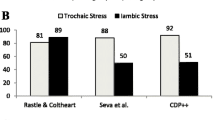Abstract
The stress contours of most English words can be generated from underlying forms which are closely related to their traditional orthographic representations. If such underlying forms are psychologically real, then native speakers should generally agree in assigning stress to unknown written words. Since some of the stress rules for English are based in part on learned Latinate vocabulary, the test words were of Latin, Greek, and Germanic origin to test for differences in performance relative to the source of the word. The results show a high degree of consistency in stress assignment but no significant differences in performance on words of different origin.
Similar content being viewed by others
References
Bolinger, D. (1964). Around the edge of language: Intonation.Harvard Educational Rev. 34(2):282–296.
Chomsky, N., and Halle, M. (1968).The Sound Pattern of English, Harper and Row, New York.
Halle, M. (1973). Stress rules in English: A new version.Linguistic Inquiry 4(4):451–464.
Halle, M., and Keyser, S. (1971).English Stress: Its Form, Its Growth, and Its Role in Verse, Harper and Row, New York.
Lehiste, I. (1970).Suprasegmentals, MIT Press, Cambridge, Mass.
Lieberman, P. (1965). On the acoustic basis of the perception of intonation by linguists.Word 21:40–54.
Lieberman, P. (1967).Intonation, Perception and Language, MIT Press, Cambridge, Mass.
Ross, R. (1972). A reanalysis of English word stress (Part I). In Brame, M. (ed.),Contributions to Generative Phonology, University of Texas Press, Austin.
Steinberg, D. (1973). Phonology, reading, and Chomsky and Halle's optimal orthography.J. Psycholing. Res. 2(3):239–258.
Thorndike, E., and Lorge, I. (1944).The Teacher's Word Book of 30,000 Words, Teachers College, Columbia University, New York.
Trammell, R. (1975). On the psychological reality of underlying phonological representations. Paper presented at the Fall Meeting of the Southeastern Conference on Linguistics, Atlanta. Submitted for publication, 1975.
Vanderslice, R., and Ladefoged, P. (1972). Binary suprasegmental features and transformational word-accentuation rules.Language 48(4):819–838.
Walsh, M. (1972). Stress rules and performance.Language and Speech 15:279–287.
Webster's New World Dictionary of the American Language, College Edition (1960). World Publishing Company, New York.
Author information
Authors and Affiliations
Rights and permissions
About this article
Cite this article
Trammell, R.L. The psychological reality of underlying forms and rules for stress. J Psycholinguist Res 7, 79–94 (1978). https://doi.org/10.1007/BF01074286
Received:
Issue Date:
DOI: https://doi.org/10.1007/BF01074286




